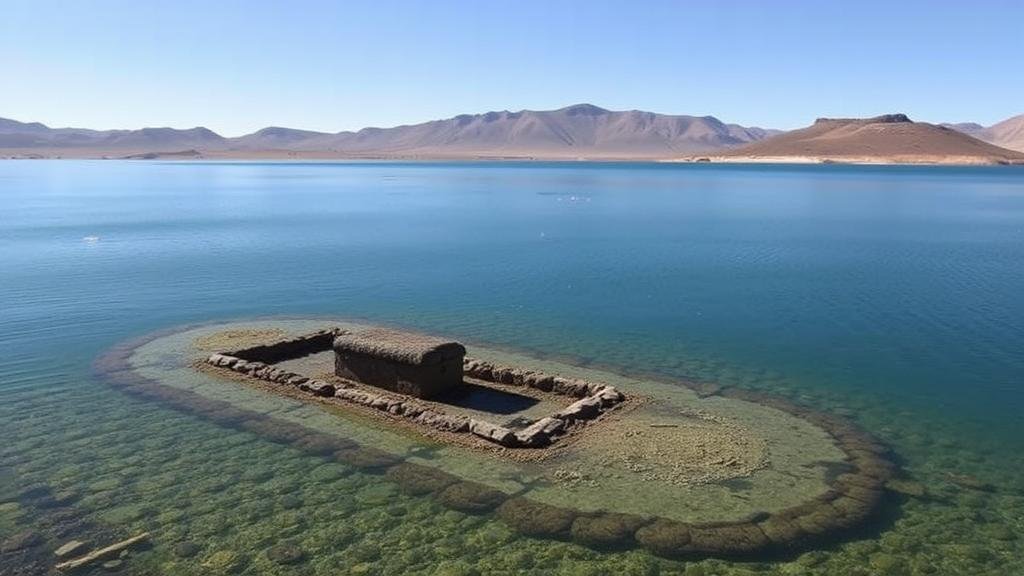Searching for submerged ceremonial sites along Lake Titicaca’s Bolivian shores.
Searching for Submerged Ceremonial Sites Along Lake Titicaca’s Bolivian Shores
Lake Titicaca, straddling the border between Bolivia and Peru, is not only the highest navigable lake in the world but also a cradle of ancient civilizations. Beneath its shimmering surface lie submerged ceremonial sites that hold the stories of the pre-Columbian people who revered this mystical body of water. This article explores the ongoing quest to uncover these submerged treasures along the Bolivian shores, their historical significance, and the methodologies employed in their discovery.
The Historical Significance of Lake Titicaca
Lake Titicaca has been a central element in the cultural and spiritual life of the indigenous peoples of the Andes for millennia. Renowned as a sacred lake by the Incas, it is believed to be the birthplace of their first king, Manco Capac. Archaeological evidence suggests that the area was inhabited as early as 2000 BC, with the Tiwanaku civilization (circa 600-1000 AD) establishing significant architectural feats along its shores.
One of the most notable structures is the Sun Temple in Tiwanaku, located approximately 15 kilometers from the lake. Researchers have documented numerous myths linking the lake to creation stories, further underscoring its importance.
Modern Discoveries and Techniques
In recent years, a renewed interest in underwater archaeology has led researchers to explore the submerged areas of Lake Titicaca, particularly along the Bolivian shores. Using advanced technologies such as sonar mapping, remotely operated vehicles (ROVs), and excavations, archaeologists are aiming to locate ceremonial sites that have long been lost to time.
- Sonar Mapping: This technology allows researchers to create detailed topographical maps of the lake bed, revealing features that might indicate human activity.
- Remotely Operated Vehicles (ROVs): Equipped with cameras and tools, ROVs enable scientists to explore underwater structures without needing divers.
- Excavation: In some areas, controlled excavations have been conducted to uncover artifacts and structures that confirm ceremonial practices.
Notable Findings
The exploration has already yielded fascinating results. For example, in 2017, researchers discovered an ancient temple submerged over 3 meters underwater near the town of Copacabana. The site contained numerous sculptures, pottery, and remnants of ritual offerings.
Another significant discovery was made in 2020 when a team located a ceremonial platform believed to be associated with Tiwanaku rituals. This platform contained ceremonial artifacts such as carved stone figurines and offerings, giving insight into the spiritual practices that once thrived around the lake.
Environmental Challenges
Despite these advances, researchers face various environmental challenges. Climate change poses a significant risk, affecting the water levels and quality of Lake Titicaca. Increased pollution and sedimentation threaten the visibility and integrity of the underwater archaeological sites, making timely studies crucial.
Also, the delicate ecosystem surrounding the lake requires a balanced approach to archaeology and preservation. Scientists are urged to work closely with local communities to ensure that explorations do not disrupt traditional practices or the environment.
The Importance of Community Engagement
Engaging local communities in research efforts is vital for the success of archaeological projects. Local knowledge can provide invaluable insights into the history and significance of sites. Collaborative initiatives have seen Bolivian indigenous groups participating in the conservation and research processes, emphasizing the importance of their cultural heritage.
- Capacity Building: Training local youth in archaeology can foster a new generation of researchers who respect and understand their heritage.
- Cultural Preservation: These initiatives help safeguard ancient practices alongside modern archaeological techniques.
Conclusion
The search for submerged ceremonial sites along Lake Titicaca’s Bolivian shores is not just an academic endeavor; it is a journey into the heart of ancestral traditions that continue to resonate today. As explorers and researchers delve into the depths of this significant lake, they uncover stories that help stitch together the rich tapestry of human history. The findings serve not only as a testament to past civilizations but also as a reminder of the importance of preserving cultural heritage for future generations.
Future archaeological endeavors should focus on integrating environmental sustainability and community involvement to maximize the benefits of archaeological discoveries while respecting indigenous traditions. The journey into Lake Titicaca’s depths holds promises for untold histories waiting to be uncovered.



